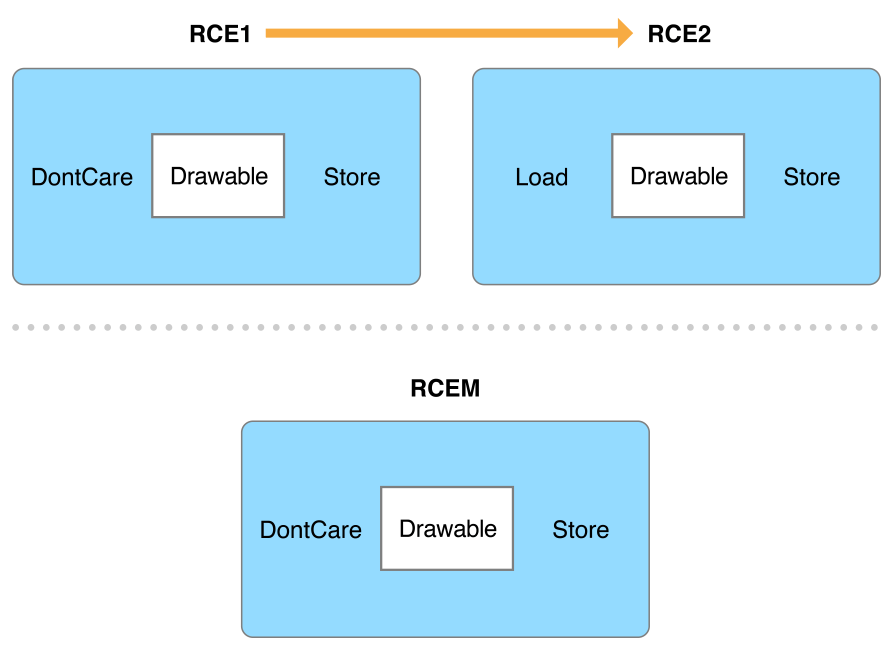Render Command Encoders (iOS and tvOS)
Best Practice: Merge render command encoders when possible.
Eliminating unnecessary render command encoders reduces memory bandwidth and increases performance. You can achieve these goals by merging render command encoders into a single rendering pass, when possible. To determine whether two render command encoders are merge-compatible or not, you must carefully evaluate their render targets, load and store actions, relationships, and dependencies. The simplest criteria for two merge-compatible render command encoders, RCE1 and RCE2, are as follows:
RCE1andRCE2are created in the same frame.RCE1andRCE2are created from the same command buffer.RCE1is created beforeRCE2.RCE2shares the same render targets asRCE1.RCE2does not sample from any render targets inRCE1.RCE1’s render target store actions are eitherStoreorDontCare, andRCE2’s render target load actions are eitherLoadorDontCare.No other render command encoders have been created between
RCE1andRCE2.
If these criteria are met, RCE1 and RCE2 can be merged into a single render command encoder, RCEM, as shown in Figure 10-1.

Additionally, if RCE1 can merge with a render command encoder created before it (RCE0) and RCE2 can merge with a render command encoder created after it (RCE3), then RCE0, RCE1, RCE2, and RCE3 can all be merged.
The following sections provide guidelines for evaluating merge compatibility between render command encoders, assuming all other criteria are met.
Evaluate Rendering Pass Order
Some apps may begin encoding into a render command encoder (RCE1) and prematurely end the initial rendering pass if they require additional dynamic data to proceed. The dynamic data is then generated in a separate rendering pass with a second render command encoder (RCE2). The initial rendering pass then continues with a third render command encoder (RCE3). Figure 10-2 shows this inefficient order, including the separated render command encoders.

If RCE2 does not depend on RCE1, then RCE2 doesn’t need to be encoded after RCE1. Encoding RCE2 first allows RCE1 and RCE3 to be merged into RCEM because they represent the same rendering pass, and their dynamic data dependencies are guaranteed to be available at the start of the rendering pass. Figure 10-3 shows this improved order, including the merged render command encoders.

Evaluate Sampling Dependencies
Render command encoders cannot be merged if there are any sampling dependencies between them. For render command encoders that share the same render targets, these dependencies may be introduced by additional render command encoders in between them, as shown in Figure 10-4.

RCE1 and RCE3 share the same render targets, RT1, RT2, and RT3. Furthermore, the actions between RCE1 and RCE3 indicate a continuation of a rendering pass. However, these render command encoders cannot be merged due to the sampling dependencies introduced by RCE2. RCE2 renders to a separate render target, RT4, which is sampled by RCE3. Additionally, RCE2 samples RT3 after it is rendered by RCE1. These sampling dependencies define a strict rendering pass order that prevents merging these render command encoders.
Evaluate Actions Between Rendering Passes
The store and load actions between render command encoder render targets are not as important as other criteria, but there are a few notable cases where additional consideration is due. Use the following guidelines to further understand merge compatibility between render command encoders RCE1 and RCE2, based on their shared render targets:
If the store action in
RCE1isStoreand the load action inRCE2isLoad, the render target is merge-compatible and is typically continuing a rendering pass.If the store action in
RCE1isDontCareand the load action inRCE2isDontCare, the render target is merge-compatible and is typically being used as an intermediary resource.If the load action in
RCE2isClear, the render target is merge-compatible if a primitive clear operation can be performed in the merged render command encoder by first rendering clear values into a display-aligned quad.
Copyright © 2018 Apple Inc. All rights reserved. Terms of Use | Privacy Policy | Updated: 2017-03-27

